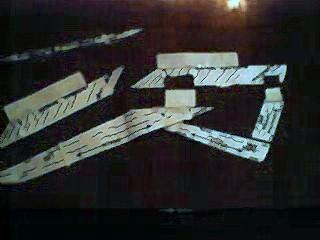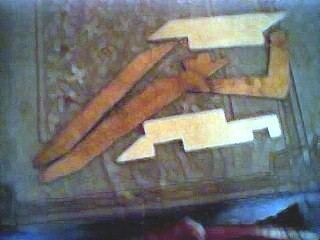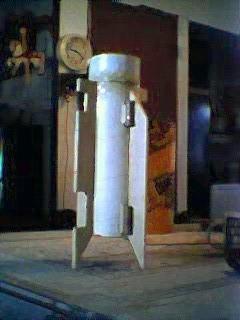Scratch Astron Spaceman 5x Original Design / Scratch Built
Scratch - Astron Spaceman 5x {Scratch}
Contributed by Herb Estus
| Manufacturer: | Scratch |
 Brief:
Brief:
This is a 5x upscale of the Estes Astron Spaceman. You can read that review
here.
Throughout, I will reference WE because this was a project that was done my
myself, the kids and their grandfather.
Construction:
These are the parts we used:
- 1/4" ply
- 7.5"x 13.75" outer tube
- 4" x 13.75 inner tube
- 2-1/2" launch lugs
- 4-8/32 t-nuts (for motor retention)
- 2-36" parachutes
- 1-4"x2" coupler
- 1-8" ball (for head)
- Fiberglass cloth
- 2-4" centering rings
- 1-1/4"x 8' tubular nylon shockcord
- 1-1/4"x4' tubular nylon shockcord
- 1-29mm tube 9" long
- 2-29mm tubes 7" long
 First thing we had to
do was upscale the fin patterns. We did this on the PC. After we got the
patterns upscaled we decided to make a few changes to them. (See the picture).
What we did was to make the legs as one piece instead of two. We did this so
the leg/arm assembly would be stronger. If you look at the picture you can see.
We also added tabs for TTW fin attachment in to the motor tube. Then small tabs
on the leg/arm assembly to the inner fin set for added strength. Notice the
picture of leg/arm assembly once they where cut out (below). Here (picture
below) you can get a better idea of the tabs I added to get everything to
interlock for strength.
First thing we had to
do was upscale the fin patterns. We did this on the PC. After we got the
patterns upscaled we decided to make a few changes to them. (See the picture).
What we did was to make the legs as one piece instead of two. We did this so
the leg/arm assembly would be stronger. If you look at the picture you can see.
We also added tabs for TTW fin attachment in to the motor tube. Then small tabs
on the leg/arm assembly to the inner fin set for added strength. Notice the
picture of leg/arm assembly once they where cut out (below). Here (picture
below) you can get a better idea of the tabs I added to get everything to
interlock for strength.


After everything was cut out we started by building the inside tube and fin assembly. At this point we only had one (1) 29mm motor tube planned. I will explain later why the other two (2) motor tubes came into play turning this rocket into a cluster. Here is a picture (above) of the inside tube with the fins attached and launch lugs on. Again you will notice the notches on the inside fins these are to interlock the leg/arm assembly.
For the leg arm assembly we used 1/4" birch plywood because we where trying to keep the weight under 4lbs. After we had the leg/arm assemblies cut out we added two coats of fiberglass cloth to both sides for strength. Doing this really stiffened up the leg/arm assembly. After the leg/arm assembly was set up, we had to cut four (4) holes into the outer 7.5" tube for the leg/arm assembly to fit into the inner fin assembly. Once we had the holes cut for the leg/arm assembly we put the inner tube into the outer tube than put the leg/arm assembly into the outer tube. Where we made the interlock for the leg/arm's to the inside fins we used fiberglass cloth and epoxy to cover this joint.
Next came making the base and adding the supports. The base was easy as it is 4 pieces of 1/4"x 13.75" long making it into a square. After the base was done we supported the main body center in the base using epoxy to secure the legs to the base. After this set up we added the outer two base supports.
At this point we felt we where doing good, the entire body with parachute and shock cord only weighed 3lbs a full pound under the target weight.
However . . .
We still had to make the head and get everything balanced right. The head is a 8" styrofoam ball coated with fiberglass resin for added strength. Once the ball was coated we epoxied the 4" coupler to the ball. We now put the head on to the body to check where are CG was and it was too far back! We needed the CG to balance at the elbows for the rocket to be stable. So we made a hole into the ball where the coupler attached and started adding lead shot until the rocket balanced at the elbows. We now re-weighed the complete rocket and were surprised to find out we added over 2lbs of shot in the head to get it balanced. So much for the target weight!
We felt this was no good but how could we still fly this with motor options. So we decided to add the other two (2) 29mm motor tubes turning this into a cluster and giving us more options for flight. We did this by drilling out the bottom centering ring only and making these tubes only 7" long to take up to a 29/180 casing.
 Flight:
Flight:
The plan when we started this was to fly it on a H128 or a H180, but after
coming in at 5.5 lbs finished the H128 was out.
But with the cluster setup now it can be flown on a variety of combinations such as:
- 3-G80's
- 1 H128 & 2 G80's
- H180
- or even possible
- 1-H180 & 2 H128
- You get the idea
For the shock cords we have a 8' 1/4" tubular nylon shockcord on the body and a 4' shockcord on the head. We decided to bring the rocket down in two pieces.
There was no need for wadding since we used a Kevlar® 'chute protector.
For the first and only flight so far we used a H180 with a short delay (6sec). We felt this would be too long of delay and it was. On the H180 the rocket took off straight up to about 500-600' then our hearts began to sink the rocket just kept coming down until about 200-250' before the ejection charge went off. However once it did both chutes and pieces came down unharmed though a little fast. Next flight we plan on going to twin 48" chutes
Summary:
Over all the kids, their grandfather and I had a lot of fun planning and
building this.
The kids already want to build another upscale of the Astron Spaceman but going to an 8x upscale to get a life size man ;-)
Sponsored Ads
 |
 |











